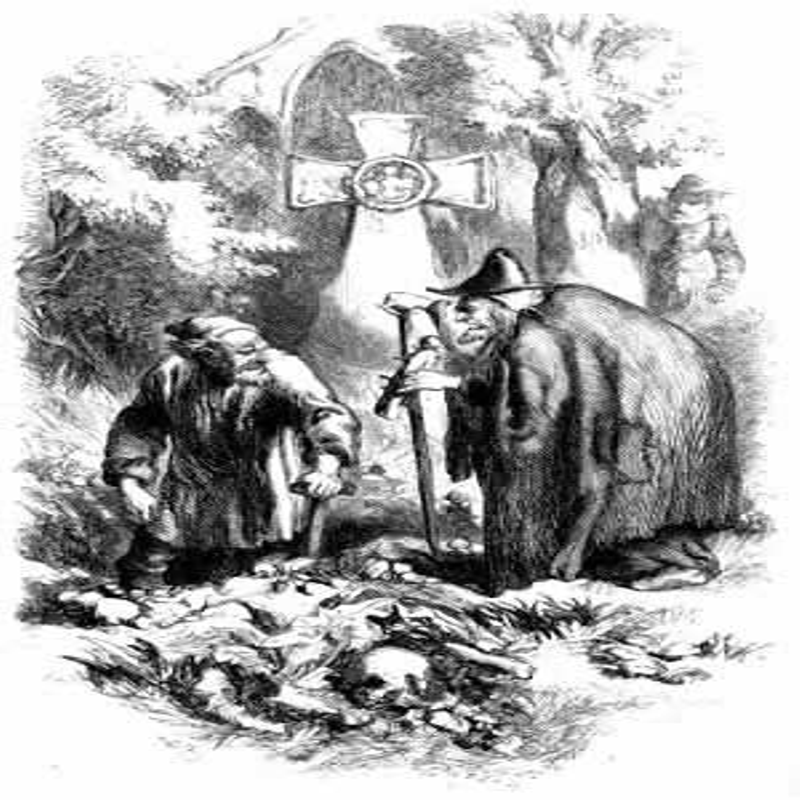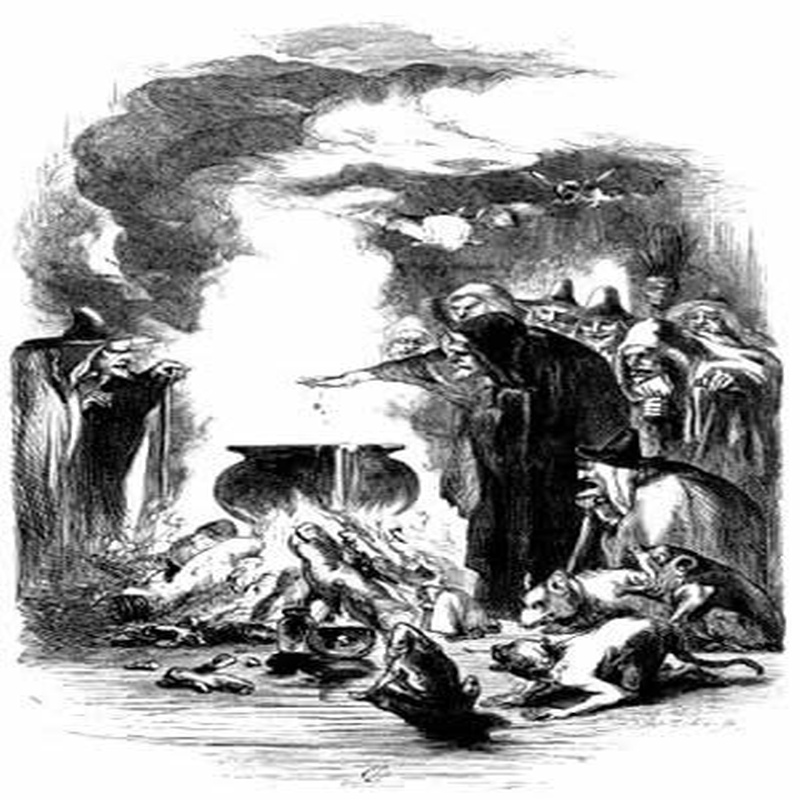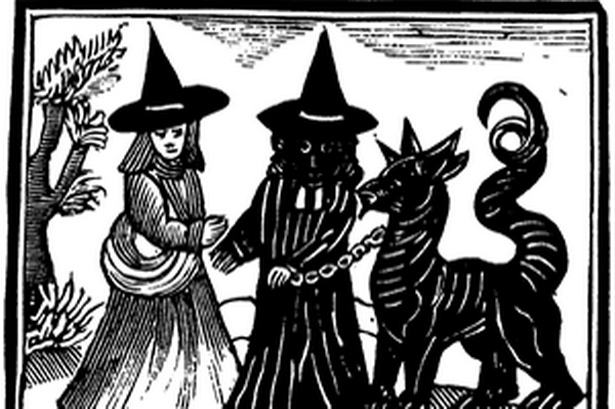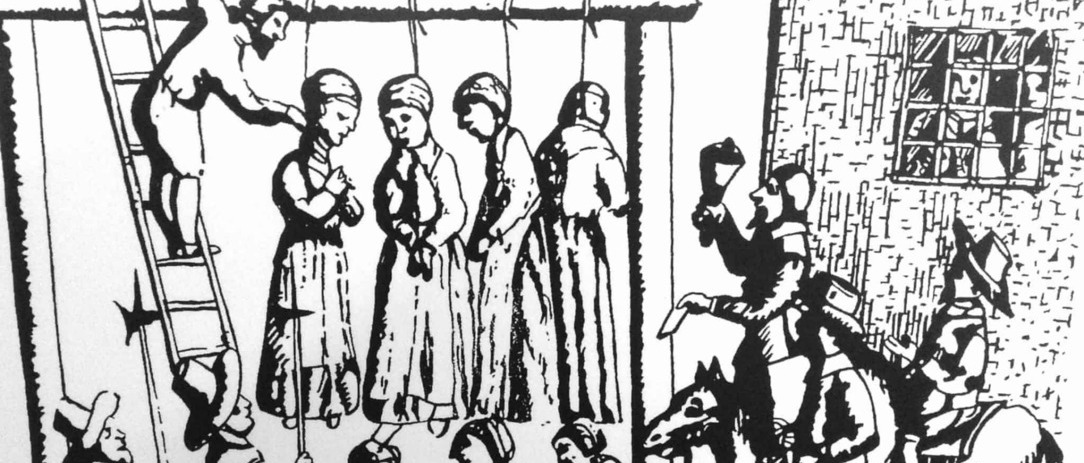Pendle Witches
Posted on 3rd March 2021
On 21 March 1612, a young woman Alizon Device was making her way through Trawden Forest near Pendle Hill in Lancashire when she encountered a peddler by the name of John Law who was travelling from Halifax on business. Alizon was a “healer” and the granddaughter of Elizabeth Southerns better known locally as Demdike, the matriarch of a family notorious for its beggary and for dabbling in witchcraft and magic.
Upon seeing that John Law was a peddler Alizon seized the opportunity to do some begging of her own. She approached him and asked him for some pins. Pins were essential in the practice of witchcraft – for the treatment of warts, for divination, and of course for acts of maleficium, but they were also expensive. It was never Alizon’s intention to pay for them and instead she implored Law to give her the pins for nothing. When he refused, she became abusive, screamed and swore and appeared to curse him. Following their harsh exchange of words John Law continued on his way before he was seen to suddenly collapse. He’d apparently had some kind of seizure. Nevertheless, he managed to struggle to his feet and stumble to a nearby Inn where he again collapsed. Witnessing this Alizon fled.

A few days later John Law’s son, Abraham, visited Alizon and demanded that she accompany him to visit his seriously ill father and lift the curse. He was in a poor way. A doctor described his condition: “His head is drawn awry, his eyes and face deformed, his speech not well to be understood, his arms lame, especially the left side.”
He was displaying all the symptoms of what we might diagnose today as a stroke.
Witnessing John Law’s condition paralysed and struggling to breathe, Alizon apologised for what she had done and begged his forgiveness. It was not forthcoming her apology being merely an admission of her guilt. John Law was to survive, but barely.
That Abraham Law had assumed from the outset that his father’s sudden illness must be the result of maleficium comes as no surprise. Lancashire at the time was a wild place that was considered by many to be outside the law. It was still largely wedded to the old Roman Catholic faith and was thought to be a place of magic and superstition. It was considered unadvisable to travel there unaccompanied not only for reasons of physical attack but because witchcraft was believed to be so commonplace.
This had remained the case even though in 1562, during the reign of Queen Elizabeth I, Parliament had passed an Act against Conjurations, Enchantments and Witchcrafts. It effectively criminalised the practice of witchcraft for the first time and provided for the death penalty where harm could be proven to have been done. Even so, little effort had been made to enforce it in unruly Lancashire.

All this was to change on 24 March 1603, when the 37 year old King James VI of Scotland was crowned King James I of England. He was a man who’d had a long and enduring interest in witchcraft. Indeed, he believed himself and his wife to have been a victim of it when storms were sent against a ship that was carrying him to Scotland. A woman, Agnes Sampson was later garrotted for supposedly having conjured up these storms.
James regularly attended the interrogation and trial of witches and in 1597 had written his book on the subject, Daemonologie. There was little doubt that he was a staunch believer in the existence and perniciousness of witchcraft, and of the necessity of rooting it out. He had written that it was the duty of people to denounce witchcraft where they found it and of the responsibility of the local authorities to prosecute practitioners of it. By 1612 he had become little more sceptical, and his views had tempered somewhat. Even so, local Magistrates were well aware of the King’s abiding interest in the practice of witchcraft and were eager to do his bidding as they saw it.
The Justice of the Peace for the area of Pendle was Roger Nowell. He was an ambitious man who had been busy prosecuting those who refused to attend Church of England services, then a criminal offence.
He had long been aware of the prominence of witchcraft in Pendle and when he received a complaint from Abraham Law regarding Alizon Device, now at last had the opportunity to prosecute it.
There were two families in Pendle who were particularly notorious for dabbling in witchcraft, the Device family also known as Demdike and the Whittle family also known as Chattox. They were despised locally for their aggressive begging and were old rivals for the services they provided.
Thomas Potts, the Clerk of the Court, in his book The Wonderful Discovery of Witches in the County of Lancashire, 1613, described the matriarchs of both families. Elizabeth Demdike he wrote:
“Was a very old woman, about the age of four score years, and had been a witch for fifty years. She dwelt in the Forest of Pendle, a vast place, fit for her profession. What she committed in her time, no man knows. Thus, she lived securely for many years, brought up her own children, instructed her grandchildren, and took great care to bring them up as witches. And certain it is, no man near them, was secure or free from danger.”
He then described Chattox:
“This Anne Whittle, alias Chattox, was a very old, withered, spent, and decrepit creature, her sight almost gone, a dangerous witch of very long continuance; always opposite to old Demdike, for whom the one favoured the other hated deadly; and how they envy and accuse one another. Her lips were always chattering and walking, but no man knew what.”
On 30 March 1612, Alizon Device, her mother Elizabeth and brother, James were summoned to appear before Roger Nowell to answer the accusations that had been made against them by Abraham Law.
Alizon Device, who was the only one of the Pendle Witches to truly believe in her own guilt quickly confessed to having sold her soul to the Devil and of calling upon her Master to lame John Law. Her brother James also testified to his sister being a servant of the Devil and of her ability to bewitch people. Elizabeth Device was more reticent in her testimony and only admitted to the fact that her own mother, Demdike, might possess something akin to the Devil’s Mark on her body.
Alizon Device did however take the opportunity to implicate the Chattox family. This she almost certainly did out of malice and revenge for in 1601 they had broken into the Device home at Malkin Tower and stolen all their goods. She also accused Old Mother Chattox of causing the death of her father whom she said was so frightened of her that every year he presented her with 8 pounds of oatmeal.
These confessions were elicited without the use of torture which was not permitted under English law until the accused had already been proven guilty. This in any case was merely a preliminary hearing and no charges had yet been brought. Nevertheless, Alizon Device was remanded in custody whilst Elizabeth and James were released.

On 2 April, Demdike and Chattox along with the latter’s daughter Anne Redferne were also summoned to appear before Roger Nowell. Both Demdike and Chattox were in their eighties, nearly blind, and hard of hearing. They were vulnerable, easily intimidated, and both quickly confessed to being servants of the Devil. Chattox said that she had willingly sold her soul after being told that she: “Would not lack for anything and get any revenge she desired.”
Anne Redferne refused to confess to any wrongdoing even though her mother had earlier said she made clay models and stuck pins in them with the intention of doing people harm.
On the basis of the evidence provided Nowell had Demdike, Chattox, Anne Redferne, and Alizon Device committed to Lancashire Jail to await trial at the next Assizes charged with the crime of maleficium or causing harm through witchcraft.
On 6 April, Elizabeth Device arranged a meeting at Malkin Tower, a rather grand name for what was little more than a ramshackle hovel, for those friends who wished to show their support for the accused members of her family while James Device stole a sheep to feed those in attendance.

When Roger Nowell learned of this, he ordered that the events at Malkin Tower be investigated. As a result of the subsequent inquiry eight of those who attended the meeting, Elizabeth Device, James Device, Alice Nutter, Katherine Hewitt, John Bulcock, James Bulcock, Alice Gray, and Jennet Preston were arrested. What had been a minor case of local maleficium had now escalated into a full-scale witch hunt.
Those arrested for witchcraft in Pendle were tried alongside a group known as the Salmesbury Witches – Jane Southworth, Jennet Brierley, Ellen Brierley, Isobel Robey and Margaret Pearson the so-called Padham Witch. It was to become known collectively as the Lancashire Witch Trials.
The two Judges charged with hearing the trial were Sir James Altham, a man nearing retirement but who was keen to make amends for having been accused of presiding over a mistrial; and Sir Edward Bromley who was eager for a promotion that would see him sent to London.
Jennet Preston who had attended the meeting at Malkin Tower was the first of the accused witches to come to trial on 27 July 1612. As she resided in neighbouring Yorkshire her case was heard at York Assizes.
This was not the first time she had been put on trial for her life. The previous year she had been accused of killing a child through witchcraft but had been found not guilty. This time the accusation was that she had caused the death of a prosperous local landowner, Thomas Lister. It was stated in Court that when she had been taken to see the corpse of the dead man and touched it the corpse had “bled fresh blood, presently, and in the presence of all those present.”
She had earlier been implicated by James Device who said she had discussed the murder at Malkin Tower. She was found guilty and hanged on 29 July.
The Lancashire Assizes opened on 18 August and none of the accused could have been in any doubt of the fate that awaited them. The main witness in the case for the Prosecution was Elizabeth Device’s nine-year-old daughter, Jennet. The evidence of a child was traditionally looked upon with some scepticism and was technically inadmissible in Court, but the Judges decided that King James had made it plain that Witch Trials were to be considered an exceptional circumstance. They ruled that her evidence was to be treated as on a par with that of any adult.
Jennet was the daughter of Elizabeth Device by a man who was not her husband. As such she had always been treated differently from the other children as if she were the runt of the litter it was suggested. It was Jennet who identified those who had been in attendance at Malkin Tower, including Alice Nutter. The Court believed her even though it seemed unlikely that Alice Nutter, the wife of a wealthy local merchant and landowner would even deign to be seen with let alone frequent the homes of uneducated, unemployed beggars but she was from a family of well-known local Catholic recusants and in the eyes of the Jury this alone would have been enough to condemn her.

Standing upon a table Jennet now told the Court how her mother was a witch and was visited regularly by a large brown dog which was her familiar and that it had been sent by the Devil. Likewise, her brother James had a familiar that was a big black dog.
As she gave her evidence her mother screamed at and cursed her from the dock. She accused her of lying, pleaded for her to stop, and shouted that she did not know what she was doing. So loud were Elizabeth’s screams that she had to be dragged from the Court.
Elizabeth Device was the only one of the accused who refused to be either intimidated or cowed by the Court. She pleaded her innocence throughout and never begged for forgiveness either from the Judges or from God. Indeed, her aggressive attitude in Court was roundly condemned. Thomas Potts was to write of her: “This odious witch who suffered from a facial deformity that resulted in her left eye being lower than her right”
Her pleas of innocence did her no good and she was convicted of maleficium and sentenced to death, as was her son James.
Elizabeth’s mother, Demdike, was likewise condemned to death though she seemed confused by the proceedings and was so hard of hearing that she could barely hear the charges brought against her or the sentence when it was read out. She was to beg forgiveness from God but accepted her fate with that degree of equanimity that often comes with old age.
Anne Whittle, Chattox, was accused of the murder of Robert Nutter who had recently died unexpectedly. She pleaded not guilty to witchcraft but the confession she had made earlier in the presence of Robert Nowell was read out in Court. After hearing this she broke down in tears, begged forgiveness from God and pleaded with the Court to be merciful to her daughter, Anne Redferne.
On 19 August, Anne Redferne was tried for murder. Like her mother before her she pleaded not guilty but her mother’s earlier testimony that she had made clay models for the purpose of meleficient acts was again read out in Court. Like Elizabeth Device before her she refused to confess and was the only one of the accused not to implicate anyone else. Regardless of this she was sentenced to death and condemned to hang.
Alizon Device whose behaviour in Trawden Forest had started the entire train of events had believed in her own guilt all along. She was contrite for having done John Law harm and begged forgiveness from God for having been a witch but accepted her fate for she knew she must die.

On 20 August 1612, at Gallows Hill in Lancaster, Elizabeth Device, Alizon Device, James Device, Anne Whittle, known as Chattox, Anne Redferne, Alice Nutter, Jane Bulcock, John Bulcock, and Katherine Hewitt also known as Mould-Heels, were hanged. They were joined by the Salmesbury Witches, Jennet Bierley, Ellen Bierley, Jane Southworth, and John Ramsden. Old Demdike had died earlier in captivity. Collectively they had been accused of sixteen murders by witchcraft over many years. Three of those arrested were later released without charge and one defendant Alice Gray was found not guilty.
The trial and execution of the Pendle and Salmesbury Witches was an unusual phenomenon in England where those convicted of witchcraft and sentenced to death had remained in the hundreds over the centuries even at a time when the Witch Craze was sweeping across Europe. Some of those hanged at Pendle were convicted of little more than guilt by association or for attending the meeting at Malkin Tower.
The trial had been driven by ambitious men, particularly Roger Nowell and Sir Edward Bromley who were seeking to ingratiate themselves with the King by being seen to clean up an area notorious for its lawlessness and high levels of Catholic recusancy. As such they were willing to rely upon the witness statement of a nine-year-old girl which was unprecedented in English law and this at a time when attitudes towards witchcraft were beginning to change and more and more of those brought before the Courts were being acquitted. Even King James whose interest in the subject of witchcraft was well-known had recently voiced his scepticism and had declared that the evidence provided in such trials should undergo rigorous examination.
Of the Judges who presided at the trial, Sir James Altham never truly restored his reputation from the previous mistrial and his reliability and honesty remained suspect for the rest of his life. He died in 1617. Sir Edward Bromley was never promoted to the London Circuit of Judges. Likewise, Roger Nowell never rose in the ranks of Government service to which he aspired.
On 24 March 1634, Jennet Device, the nine year old girl, upon whose evidence so many of her family and their friends were hanged was herself arrested for witchcraft. It is known that she was still in prison as late as August 1636, though her eventual fate remains a mystery.
Tagged as: Tudor & Stuart, Women
Share this post:





